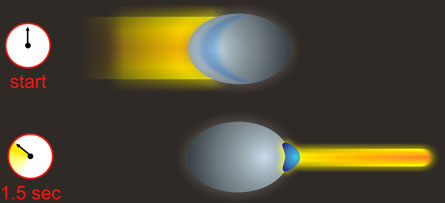- More than 2 years ago
Forget about ziplock bags. A cloud of ultracold atoms can store a beam of yellow light for 1.5 seconds. That timescale isn’t impressive for frozen peas, but it’s enough time for light to circle the Earth 10 times under normal conditions, researchers led by Lene Hau of Harvard University report.

This ability to store light may lead to more efficient ways to communicate, as well as new ways to explore quantum mechanical properties such as entanglement.
The new study is “a beautiful demonstration,” says Irina Novikova, a physicist at the College of William & Mary in Williamsburg, Va. Before this result, she says, light storage was measured in milliseconds. “Here, it’s fractional seconds. It’s a really dramatic time.”
Researchers knew that the information carried in light pulses could be transferred to clouds of ultracold atoms, called Bose-Einstein condensates. In this technique, a laser called a control laser prepares the atomic cloud for an incoming light beam. As the photons fly in, they leave an imprint in a subset of the atoms. This imprint, stored in a quantum property known as spin, contains all the relevant information needed to reconstitute the light beam. But the imprint is fragile and deteriorates in milliseconds. The light’s information is lost as other atoms in the cloud interfere with the imprint.
Hau and colleagues overcame this problem by sequestering the matter imprint from the rest of the atoms in the cloud. The team shone a pulse of laser light — which looks like the yellow light from street lamps, Hau says — into a small cloud of sodium atoms. A three-microsecond pulse produced a stretch of light about a kilometer long, but as the pulse entered the atom cloud, it began to compress. Like an accordion closing, the light folded up and crammed itself into a space just 0.02 millimeters long. The spin states of the sodium atoms in the light’s path were changed, forming the matter imprint. By turning off the control laser, the researchers were able to freeze the matter imprint.
Next, the researchers strengthened the magnetic field applied to the atom cloud to protect the imprint from interfering atoms. At a certain magnetic field, Hau says, interactions between the imprint and the rest of the atoms start to become repulsive, and the imprint separates from the cloud like a drop of oil in water. “This matter imprint digs a little hole for itself in the condensate,” Hau says. “It can snugly sit there for long periods of time.”
After waiting 1.5 seconds, the team revived the light beam. First, the researchers coaxed the matter imprint to the outside of the cloud by changing the magnetic field, and then they turned the control laser back on. The light beam that emerged from the atom cloud was weaker than the light beam that went in but similar in other regards, such as frequency and polarization, Hau says. Improving the stability of the magnetic field will likely lead to longer storage times, she adds.
This new method is a vast improvement over earlier methods, the researchers report in their paper, published December 4 in Physical Review Letters. The fidelity of the reconstructed light beam is 100 times better than earlier attempts, Hau says.
Transferring information between light and atoms could one day lead to better communication networks. Light-storage devices could also enable quantum communication, says quantum physicist Ortwin Hess of the University of Surrey in Guildford, England, who calls the new study “elegant and impressive.”







